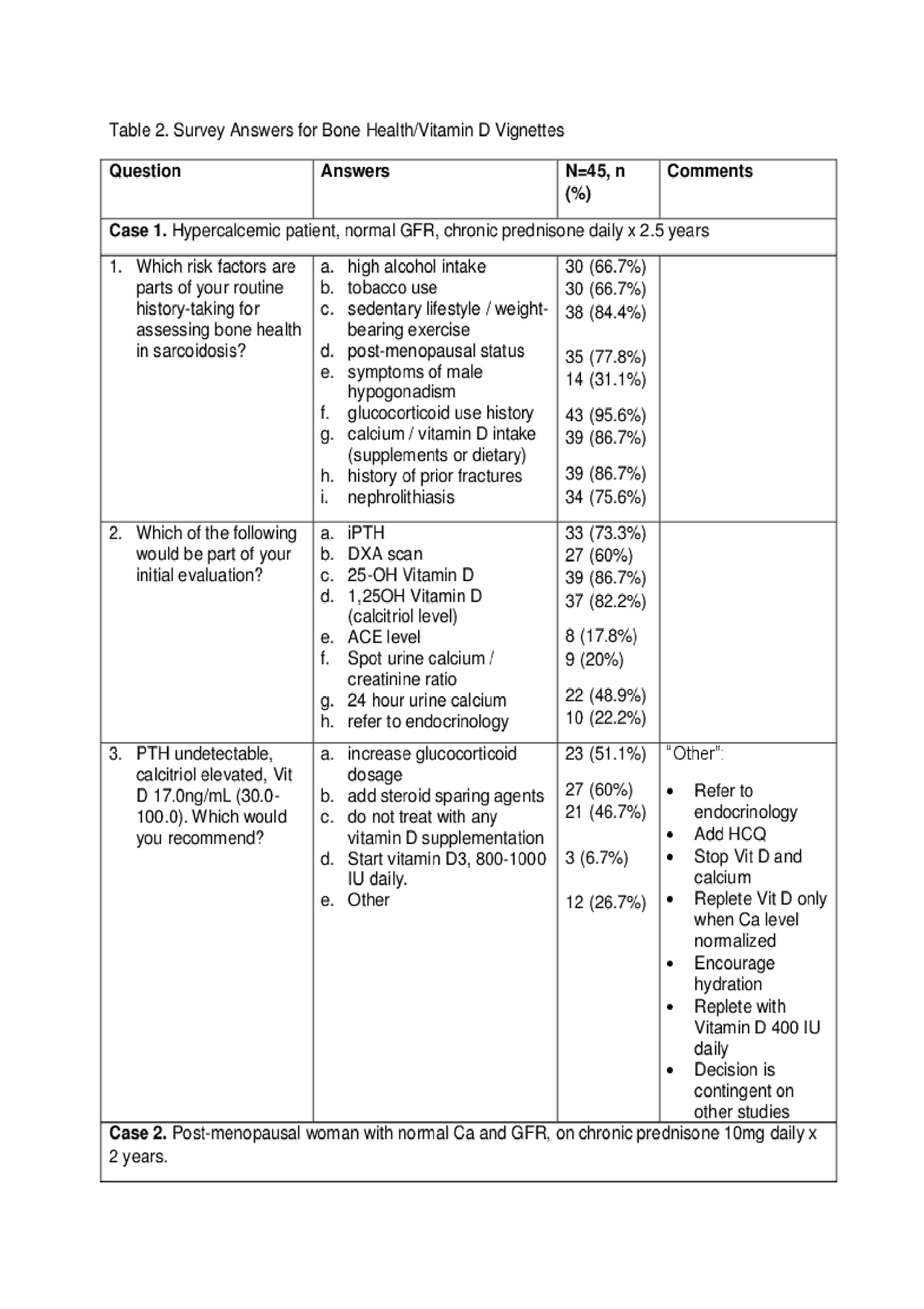Session Information
Session Type: Poster Session (Sunday)
Session Time: 9:00AM-11:00AM
Background/Purpose: Sarcoidosis is a multisystem disease caused by granulomatous inflammation of unclear etiology. Hypercalcemia, seen in 2-30% of patients with sarcoidosis, is caused by calcitriol overproduction by macrophages within granulomas. Low Vitamin D 25OH (VitD) is common and contributes to low bone mass. VitD repletion can lead to hypercalcemia, but there are limited data regarding safe VitD repletion in these patients. We surveyed physicians from varying specialties who manage patients with sarcoidosis to assess current practice patterns.
Methods: Two clinical vignettes regarding bone health and VitD in sarcoidosis were presented. Clinical Vignette #1 presented a patient with hypercalcemia, elevated calcitriol, and VitD insufficiency. Clinical Vignette #2 presented a patient with normal calcium and calcitriol, VitD insufficiency, and low bone mass. These were followed by questions regarding evaluation and therapy. The survey was distributed to physicians (1) in the divisions of Pulmonary/Critical Care, Rheumatology, Neurology, Endocrinology, and Cardiology at the Virginia Commonwealth University, (2) who attended the 2019 annual Americas Association of Sarcoidosis and other Granulomatous Disorders meeting, and (3) in a national listserv for sarcoidosis which includes approximately 100 physicians with an interest in sarcoidosis. Participants were asked to complete the vignettes they felt were pertinent to their practice and were informed that there were no incorrect answers.
Results: 45 physicians responded to the survey; the majority were pulmonologists (55.5%), followed by rheumatologists (26.7%) and endocrinologists (8.9%). They were predominantly from an academic hospital setting (93.4%). Over 75% of all physicians assessed patients for 6 of the 9 listed risk factors related to bone health. Only 31.1% assessed for symptoms of male hypogonadism. More than half of all respondents chose PTH, DXA scan, VitD, and calcitriol as part of their evaluation, while response rates to obtain serum ACE level varied between 0 to 33% among specialists. In patients with hypercalcemia, 46.7% opted not to give VitD supplementation for the VitD level that was presented. In patients without hypercalcemia, 33.3% chose not to supplement VitD at the presented level, while at least 28.9% would supplement with low dose VitD. In patients with osteopenia, 80% of respondents would recommend weight-bearing exercise and 35.6% would recommend a bisphosphonate. For patients with osteoporosis, 71.1% recommend a bisphosphonate and only 35.6% would opt to maintain VitD above 30ng/mL.
Conclusion: Maintaining strong bone health in a patient with sarcoidosis can be complicated given the risk of hypercalcemia. Though not all patients are hypercalcemic at baseline, it is unclear if Vitamin D supplementation can lead to hypercalcemia. This survey highlights the differences in practices in promoting healthy bones in sarcoidosis patients, stressing the importance of developing guidelines for safe Vitamin D repletion.
To cite this abstract in AMA style:
Syed H, George T, Iden T, Syed A, Gerke A, Le T. Practice Patterns in Bone Health and Vitamin D Management in Sarcoidosis: A Survey of Physicians Who Manage Sarcoidosis [abstract]. Arthritis Rheumatol. 2019; 71 (suppl 10). https://acrabstracts.org/abstract/practice-patterns-in-bone-health-and-vitamin-d-management-in-sarcoidosis-a-survey-of-physicians-who-manage-sarcoidosis/. Accessed .« Back to 2019 ACR/ARP Annual Meeting
ACR Meeting Abstracts - https://acrabstracts.org/abstract/practice-patterns-in-bone-health-and-vitamin-d-management-in-sarcoidosis-a-survey-of-physicians-who-manage-sarcoidosis/



